Fujitsu LifeBook E6540, LifeBook C6547, LifeBook E6556, LifeBook E6570, LifeBook C6556 User Manual

Copyright
Fujitsu PC Corporation has made every effort to ensure the accuracy and completeness of this document. However, as ongoing development efforts are continually improving the capabilities of our products, we cannot guarantee the accuracy of the contents of this document. We disclaim liability for errors, omissions, or future changes.
Fujitsu and the Fujitsu logo are registered trademarks and LifeBook is a trademark of Fujitsu Limited.
First Cabin is a service mark of Fujitsu PC Corporation.
The following are registered trademarks of IBM Corporation: IBM, IBM PC AT, IBM PS/2.
The following are registered trademarks of Microsoft Corporation: MS, MS-DOS, Windows.
PCMCIA is a trademark of the Personal Computer Memory Card International Association.
Intel and Pentium are registered trademarks and SpeedStep is a trademark of Intel Corporation.
Adobe Acrobat Reader is a registered trademark of Adobe System Inc.
CompuServe and AOL are registered trademarks of America Online, Inc.
C o p y r i g h t
Earthlink is a registered trademark of EarthLink Network, Inc.
Quicken®2000 is a registered trademark of Intuit, Inc.
Sony MiniDisk is a trademark of Sony Electronics, Inc.
Philips is a trademark of Koninklijke Philips Electronics N.V.
Netscape Communicator is a registered trademark of Netscape Communications Corporation.
PC-Doctor is a trademark of PC-Doctor.com, Inc.
LapLink is a registered trademark of LapLink.com, Inc.
McAfee is a registered trademark of Network Associates/ McAfee.com, Inc.
All other trademarks mentioned herein are the property of their respective owners.
© Copyright 2000 Fujitsu PC Corporation. All rights reserved. No part of this publication may be copied, reproduced, or translated, without prior written consent of Fujitsu PC Corporation. No part of this publication may be stored or transmitted in any electronic form without the written consent of Fujitsu PC Corporation.
FPC58-0397-01
DECLARATION OF CONFORMITY according to FCC Part 15
Responsible Party Name: |
Fujitsu PC Corporation |
Address: |
5200 Patrick Henry Drive |
|
Santa Clara, CA 95054 |
Telephone: |
(408) 982-9500 |
Declares that: |
LifeBook C Series Configuration: |
|
LifeBook C-6577 |
|
LifeBook C-6556 |
|
LifeBook C-6547 |
|
Complies with Part 15 of the FCC Rules. |
This device complies with Part 15 of the FCC rules. Operations are subject to the following two conditions:
(1) This device must not be allowed to cause harmful interference, (2) This device must accept any interference received, including interference that may cause undesired operation.

L i f e B o o k C S e r i e s
 C A U T I O N
C A U T I O N
Changes or modifications not expressly approved by Fujitsu PC Corporation could void this user’s authority to operate the equipment.
FCC NOTICES
Notice to Users of Radios and Television
These limits are designed to provide reasonable protection against harmful interference in a residential installation. This equipment generates, uses, and can radiate radio frequency energy and, if not installed and used in accordance with the instructions, may cause harmful interference to radio communications. However, there is no guarantee that interference will not occur in a particular installation. If this equipment does cause harmful interference to radio or television reception, which can be determined by turning the equipment off and on, the user is encouraged to try to correct the interference by one or more of the following measures:
■Reorient or relocate the receiving antenna.
■Increase the separation between the equipment and receiver.
■Connect the equipment into an outlet that is on a different circuit than the receiver.
■Consult the dealer or an experienced radio/TV technician for help.
Shielded interconnect cables must be employed with this equipment to ensure compliance with the pertinent RF emission limits governing this device.
Notice to Users of the US Telephone Network
Your Fujitsu LifeBook may be supplied with an internal modem which complies with Part 68 of the FCC rules. On this LifeBook is a label that contains the FCC Registration Number and the Ringer Equivalence Number (REN) for this equipment among other information. If requested, the user must provide their telephone company with the following information:
1.The telephone number to which the LifeBook is connected.
2.The Ringer Equivalence Number (REN) for this equipment.
3.That the equipment requires a standard modular jack type USOC RJ-11C which is FCC Part 68 compliant.
4.The FCC Registration Number.
This equipment is designed to be connected to the telephone network or premises wiring using a standard modular jack type USOC RJ-11C which is FCC Part 68 compliant and a line cord between the modem and the telephone network with a minimum of 26AWG.
The REN is used to determine the number of devices that you may connect to your telephone line and still have all of those devices ring when your number is
called. Too many devices on one line may result in failure to ring in response to an incoming call. In most, but not all, areas the sum of the RENs of all of the devices should not exceed five (5). To be certain of
the number of devices you may connect to your line, as determined by the RENs, contact your local telephone company.
If this equipment causes harm to the telephone network, your telephone company may discontinue your service temporarily. If possible, they will notify you in advance. If advance notice is not practical they will notify you as soon as possible. You will also be advised of your right to file a complaint with the FCC.
This fax modem also complies with fax branding requirements per FCC Part 68.
Your telephone company will probably ask you to disconnect this equipment from the telephone network until the problem is corrected and you are sure that the equipment is not malfunctioning. This equipment may not be used on coin-operated telephones provided by your telephone company. Connection to party lines is subject to state tariffs. Contact your state’s public utility commission, public service commission or corporation commission for more information.
This equipment includes automatic dialing capability. When programming and/or making test calls to emergency numbers:
■Remain on the line and briefly explain to the dispatcher the reason for the call.
■Perform such activities in off-peak hours, such as early morning or late evening.
FCC rules prohibit the use of non-hearing aid compatible telephones in the following locations or applications:
■All public or semipublic coin-operated or credit card telephones.
■Elevators, highways, tunnels (automobile, subway, railroad or pedestrian) where a person with impaired hearing might be isolated in an emergency.
■Places where telephones are specifically installed to alert emergency authorities such as fire, police or medical assistance personnel.
■Hospital rooms, residential health care facilities, convalescent homes and prisons.
■Workstations for the hearing impaired.
■Hotel, motel or apartment lobbies.
■Stores where telephones are used by patrons to order merchandise.
■Public transportation terminals where telephones are used to call taxis or to reserve lodging or rental cars.
■In hotel and motel rooms as at least ten percent of the rooms must contain hearing aid compatible telephones or jacks for plug-in hearing aid compatible telephones which will be provided to hearing impaired customers on request.

DOC (INDUSTRY CANADA) NOTICES Notice to Users of Radios and Television
This Class B digital apparatus meets all requirements of the Canadian InterferenceCausing Equipment Regulations.
CET appareil numérique de la class B respecte toutes les exigence du Réglement sur le matérial brouilleur du Canada.
Notice to Users of the Canadian Telephone Network
The Canadian Industry Canada label identifies certified equipment. This certification means that the equipment meets certain telecommunications network protective, operational, and safety requirements. The Department does not guarantee the equipment will operate to the user’s satisfaction.
Fujitsu LifeBook computers are supplied with an internal modem which complies with the Industry Canada certification standards for telecommunication network protection and safety requirements. Before connecting this equipment to a telephone line the user should ensure that it is permissible to connect this equipment to the local telecommunication facilities. The user should be aware that compliance with the certification standards does not prevent service
degradation in some situations.
Repairs to telecommunication equipment should be made by a Canadian authorized maintenance facility. Any repairs or alterations not expressly approved by Fujitsu™ PC Corporation or any equipment failures may give the telecommunication company cause to request the user to disconnect the equipment from the telephone line.
The connecting arrangement code for this equipment is CA11A.
The Load Number is 0.3.
The Load Number assigned to each telephone terminal device denotes the percentage of the total load to be connected to a telephone loop or circuit which is used by the device to prevent overloading. The termination on a loop may consist of any combination of devices such that the total of the load numbers of all devices does not exceed 100.
 C A U T I O N
C A U T I O N
For safety, users should ensure that the electrical ground of the power utility, the telephone lines and the metallic water pipes are connected together. Users should NOT attempt to make such connections themselves but should contact the appropriate electric inspection authority or electrician. This may be particularly important in rural areas.
C o p y r i g h t
Avis Aux Utilisateurs Du Réseau Téléphonique Canadien
L’étiquette canadienne Industrie Canada identifie l’équipement certifié. Cette certification signifie que l’équipement satisfait certaines normes de protection, d’exploitation et de sécurité des réseaux de télécommunications. Le département ne garantit pas le fonctionnement de l’équipement à la satisfaction de l’utilisateur.
La série LifeBookTM E possède un modem interne conforme aux normes de certification d’Industrie Canada pour protéger les réseaux de télécommunications et satisfaire aux normes de sécurité. Avant de connecter cet équipement à une ligne téléphonique, l’utilisateur doit vérifier s’il est permis de connecter cet équipement aux installations de télécommunications locales. L’utilisateur est averti que même la conformité aux normes de certification ne peut dans certains cas empêcher la dégradation du service.
Les réparations de l’équipement de télécommunications doivent être eVectuées par un service de maintenance agréé au Canada. Toute réparation ou modification, qui n’est pas expressément approuvée par Fujitsu PC Corp., ou toute défaillance de l’équipement peut entraîner la compagnie de télécommunications à exiger que l’utilisateur déconnecte l’équipement de la ligne téléphonique.
Le code d’arrangement de connexion de cet équipement est CA11A.
Le numéro de charge est 0.3.
Le numéro de charge assigné à chaque terminal téléphonique indique le pourcentage de la charge totale pouvant être connecté à une boucle ou à un circuit téléphonique, utilisé par ce périphérique afin de prévenir toute surcharge. La terminaison d’une boucle peut être constituée de n’importe quelle combinaison de périphériques de sorte que le total de numéros de charge de tous les périphériques n’excède pas 100.
 A V E R T I S S E M E N T
A V E R T I S S E M E N T
Pour assurer la sécurité, les utilisateurs doivent vérifier que la prise de terre du service d’électricité, les lignes télphoniques et les conduites d’eau métalliques sont connectées ensemble. Les utilisateurs NE doivent PAS tenter d’établir ces connexions eux-mêmes, mais doivent contacter les services d’inspection d’installations électriques appropriés ou un électricien. Ceci peut être particulièrement important en régions rurales.
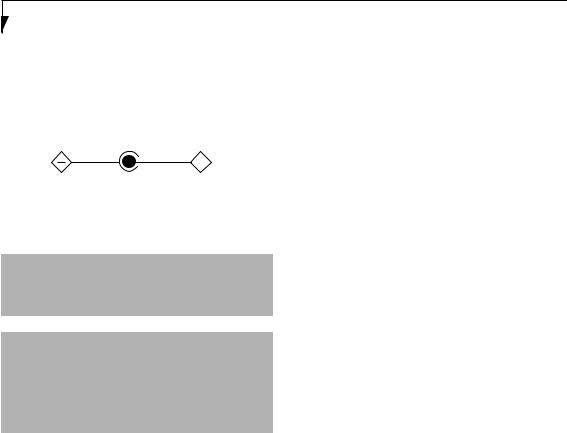
L i f e B o o k C S e r i e s
UL Notice
This unit requires an AC adapter to operate. Use only UL Listed Class 2 Adapters with an output rating of 16 Vdc, with a current of 3.36 A.
AC Adapter output polarity:
+
The modem-to-telephone network connection must be a line cord using a minimum #26 AWG wire.
For Authorized Repair Technicians Only
 C A U T I O N
C A U T I O N
For continued protection against risk of fire, replace only with the same type and rating fuse.
 C A U T I O N
C A U T I O N
Danger of explosion if Lithium (clock) battery is incorrectly replaced. Replace only with the same or equivalent type recommended by the manufacturer. Dispose of used batteries according to the manufacturer’s instruction.

T a b l e o f C o n t e n t s
Fujitsu C Series LifeBook
Table of Contents
1
PREFACE
Preface
About This Guide . . . . . . . . . . . . . . . . . . . . . . . . . 3
Fujitsu PC Contact Information . . . . . . . . . . . . . . 3
Warranty . . . . . . . . . . . . . . . . . . . . . . . . . . . . . . . 3
2
GETTING TO KNOW YOUR LIFEBOOK
Overview
Unpacking . . . . . . . . . . . . . . . . . . . . . . . . . . . . . . 7
LifeBook Features. . . . . . . . . . . . . . . . . . . . . . . . . 8
LifeBook Software . . . . . . . . . . . . . . . . . . . . . . . . 8
Popular Accessories . . . . . . . . . . . . . . . . . . . . . . . 8
Locating the Controls
and Connectors
Top and Front Components . . . . . . . . . . . . . . . . . 9
Left-Side Panel Components . . . . . . . . . . . . . . . 11
Right-Side Panel Components . . . . . . . . . . . . . . 12
BACK Panel Components. . . . . . . . . . . . . . . . . . 13
Bottom Components . . . . . . . . . . . . . . . . . . . . . 15
CoolView Display
Mode Indicator . . . . . . . . . . . . . . . . . . . . . . . . . 16
CD Mark . . . . . . . . . . . . . . . . . . . . . . . . . . . . . . 16
CD Track . . . . . . . . . . . . . . . . . . . . . . . . . . . . . . 16
Volume Level Indicator. . . . . . . . . . . . . . . . . . . . 16
Suspend/Resume Indicator. . . . . . . . . . . . . . . . . 16
AC Adapter Indicator . . . . . . . . . . . . . . . . . . . . 17
Battery Level Indicators. . . . . . . . . . . . . . . . . . . 17
Battery Charging Indicators. . . . . . . . . . . . . . . . 17
DVD Drive Access Indicator . . . . . . . . . . . . . . . 17
Hard Drive Access Indicator . . . . . . . . . . . . . . . 18
Floppy Disk Drive Access Indicator . . . . . . . . . . 18
PC Card Access Indicators. . . . . . . . . . . . . . . . . 18
NumLk Indicator . . . . . . . . . . . . . . . . . . . . . . . . 18
CapsLock Indicator . . . . . . . . . . . . . . . . . . . . . . 18
ScrLk Indicator . . . . . . . . . . . . . . . . . . . . . . . . . 18
Keyboard
Using the Keyboard . . . . . . . . . . . . . . . . . . . . . . 19
Numeric Keypad . . . . . . . . . . . . . . . . . . . . . . . . 19
Windows Keys . . . . . . . . . . . . . . . . . . . . . . . . . . 19
Cursor Keys . . . . . . . . . . . . . . . . . . . . . . . . . . . . 19
Function Keys . . . . . . . . . . . . . . . . . . . . . . . . . . 20
Touchpad Pointing Device
Clicking . . . . . . . . . . . . . . . . . . . . . . . . . . . . . . . 21
Double-Clicking . . . . . . . . . . . . . . . . . . . . . . . . . 21
Dragging . . . . . . . . . . . . . . . . . . . . . . . . . . . . . . 22
Scrolling. . . . . . . . . . . . . . . . . . . . . . . . . . . . . . . 22
Touchpad Control Adjustment . . . . . . . . . . . . . . 22
Volume Control
Controlling the Volume . . . . . . . . . . . . . . . . . . . 23
Setting the Hardware Volume Control . . . . . . . . 23
LifeBook Application Panel
Selector Switch . . . . . . . . . . . . . . . . . . . . . . . . . 24 Application Launch CD Player Buttons . . . . . . . . 24 CoolView Display. . . . . . . . . . . . . . . . . . . . . . . . 24 Configuring your LifeBook Application Panel . . . 24 Using the CD Player. . . . . . . . . . . . . . . . . . . . . . 25 Desktop Control Panel . . . . . . . . . . . . . . . . . . . . 26

 L i f e B o o k C S e r i e s
L i f e B o o k C S e r i e s
Pre-Installed Software
Learning About Your Applications . . . . . . . . . . . 28 PC-Doctor for Windows. . . . . . . . . . . . . . . . . . . 28 LapLink 2000 . . . . . . . . . . . . . . . . . . . . . . . . . . . 28 Quicken 2000 Basic . . . . . . . . . . . . . . . . . . . . . . 28 McAfee.com ActiveShield. . . . . . . . . . . . . . . . . . 28 McAfee.com Clinic (On-Line Coupon) . . . . . . . . 28 PMSet 98 . . . . . . . . . . . . . . . . . . . . . . . . . . . . . . 28 Adobe Acrobat Reader . . . . . . . . . . . . . . . . . . . . 28 Intel Speedstep. . . . . . . . . . . . . . . . . . . . . . . . . . 28 LifeBook Application Panel Software . . . . . . . . . 28
3
GETTING STARTED
Power Sources
Connecting the Power Adapters. . . . . . . . . . . . . 31
Display Panel
Opening the Display Panel. . . . . . . . . . . . . . . . . 32
Adjusting Display Panel Brightness . . . . . . . . . . . 32
Closing the Display Panel . . . . . . . . . . . . . . . . . . 32
Starting Your LifeBook
Power On . . . . . . . . . . . . . . . . . . . . . . . . . . . . . 33 Boot Sequence . . . . . . . . . . . . . . . . . . . . . . . . . . 33 BIOS Setup Utility . . . . . . . . . . . . . . . . . . . . . . . 33 Booting the System with
Windows 98 Second Edition . . . . . . . . . . . . . . . 34 Registering Your LifeBook . . . . . . . . . . . . . . . . . 35
Power Management
Suspend/Resume Button . . . . . . . . . . . . . . . . . . 36
Suspend Mode. . . . . . . . . . . . . . . . . . . . . . . . . . 36
Hibernation (Save-to-Disk) Feature . . . . . . . . . . 36
Standby Mode . . . . . . . . . . . . . . . . . . . . . . . . . . 37
Display Timeout . . . . . . . . . . . . . . . . . . . . . . . . . 37
Hard Disk Timeout . . . . . . . . . . . . . . . . . . . . . . . 37
Windows 98 Second Edition
Power Management. . . . . . . . . . . . . . . . . . . . . . 37
Restarting the System. . . . . . . . . . . . . . . . . . . . . 37
Power Off . . . . . . . . . . . . . . . . . . . . . . . . . . . . . 38
4
USER INSTALLABLE FEATURES
Lithium ion Battery
Recharging the Batteries . . . . . . . . . . . . . . . . . . 41 Replacing the Battery. . . . . . . . . . . . . . . . . . . . . 42
Floppy Disk Drive
Loading a Disk . . . . . . . . . . . . . . . . . . . . . . . . . . 43 Ejecting a Disk . . . . . . . . . . . . . . . . . . . . . . . . . . 43 Preparing a Disk for Use . . . . . . . . . . . . . . . . . . 43
DVD Drive
DVD Player Software . . . . . . . . . . . . . . . . . . . . . 44 Loading a DVD/CD . . . . . . . . . . . . . . . . . . . . . . 45 Removing a DVD/CD . . . . . . . . . . . . . . . . . . . . 45 Using the DVD Player Software . . . . . . . . . . . . . 45 Using the DVD Player on Battery Power . . . . . . 46 Auto Insert Notification Function . . . . . . . . . . . . 46
PC Cards
Installing PC Cards. . . . . . . . . . . . . . . . . . . . . . . 47
Removing PC Cards . . . . . . . . . . . . . . . . . . . . . . 48
Memory Upgrade
Module
Installing a Memory Upgrade Module . . . . . . . . 49
Removing a Memory Upgrade Module . . . . . . . 50
Checking the Computer Recognition
of New Memory Capacity . . . . . . . . . . . . . . . . . 50
Device Ports
Modem (RJ-11) Telephone Jack. . . . . . . . . . . . . 51
Parallel Port . . . . . . . . . . . . . . . . . . . . . . . . . . . . 51
Serial Port . . . . . . . . . . . . . . . . . . . . . . . . . . . . . 51
PS/2 Port . . . . . . . . . . . . . . . . . . . . . . . . . . . . . . 51
Universal Serial Bus Port. . . . . . . . . . . . . . . . . . . 51
1394 Port . . . . . . . . . . . . . . . . . . . . . . . . . . . . . 51
Infrared Port . . . . . . . . . . . . . . . . . . . . . . . . . . . 52
Wireless Infrared (IR) Mouse Receiver . . . . . . . . 52
Microphone Jack . . . . . . . . . . . . . . . . . . . . . . . . 52
Stereo Line-In Jack. . . . . . . . . . . . . . . . . . . . . . . 52
Digital Audio-Out Connector. . . . . . . . . . . . . . . 52

T a b l e o f C o n t e n t s
S-Video Out Port . . . . . . . . . . . . . . . . . . . . . . . . 53
Headphone Jack. . . . . . . . . . . . . . . . . . . . . . . . . 53
External Monitor Port. . . . . . . . . . . . . . . . . . . . . 53
5
TROUBLESHOOTING
Troubleshooting
Identifying the Problem . . . . . . . . . . . . . . . . . . . 57
Specific Problems . . . . . . . . . . . . . . . . . . . . . . . . 57
Troubleshooting Table . . . . . . . . . . . . . . . . . . . . 58
Power On Self Test Messages . . . . . . . . . . . . . . 67
Emergency DVD Tray Release . . . . . . . . . . . . . . 69
Modem Result Codes. . . . . . . . . . . . . . . . . . . . . 69
Recovery CD-ROM . . . . . . . . . . . . . . . . . . . . . . 69
6
CARE AND MAINTENANCE
Care and Maintenance
Fujitsu LifeBook . . . . . . . . . . . . . . . . . . . . . . . . . 73
Batteries . . . . . . . . . . . . . . . . . . . . . . . . . . . . . . . 74
Floppy Disks and Drives . . . . . . . . . . . . . . . . . . . 74
DVDs and CDs. . . . . . . . . . . . . . . . . . . . . . . . . . 75
PC Cards . . . . . . . . . . . . . . . . . . . . . . . . . . . . . . 75
7
SPECIFICATIONS
Specifications
Configuration Label . . . . . . . . . . . . . . . . . . . . . . 79
Microprocessor . . . . . . . . . . . . . . . . . . . . . . . . . 80
Memory. . . . . . . . . . . . . . . . . . . . . . . . . . . . . . . 80
Video. . . . . . . . . . . . . . . . . . . . . . . . . . . . . . . . . 80
Audio. . . . . . . . . . . . . . . . . . . . . . . . . . . . . . . . . 80
Mass Storage Device Options . . . . . . . . . . . . . . 80
Features. . . . . . . . . . . . . . . . . . . . . . . . . . . . . . . 80
Device Ports. . . . . . . . . . . . . . . . . . . . . . . . . . . . 80
Keyboard . . . . . . . . . . . . . . . . . . . . . . . . . . . . . . 81
Power . . . . . . . . . . . . . . . . . . . . . . . . . . . . . . . . 81
Dimensions and Weight. . . . . . . . . . . . . . . . . . . 81
Environmental Requirements . . . . . . . . . . . . . . . 81
8
GLOSSARY
Glossary. . . . . . . . . . . . . . . . . . . . . . . . . . . . . . . 85

 L i f e B o o k C S e r i e s
L i f e B o o k C S e r i e s
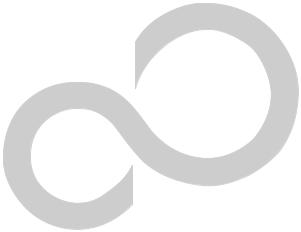
1
Preface
1

 L i f e B o o k C S e r i e s
L i f e B o o k C S e r i e s
2
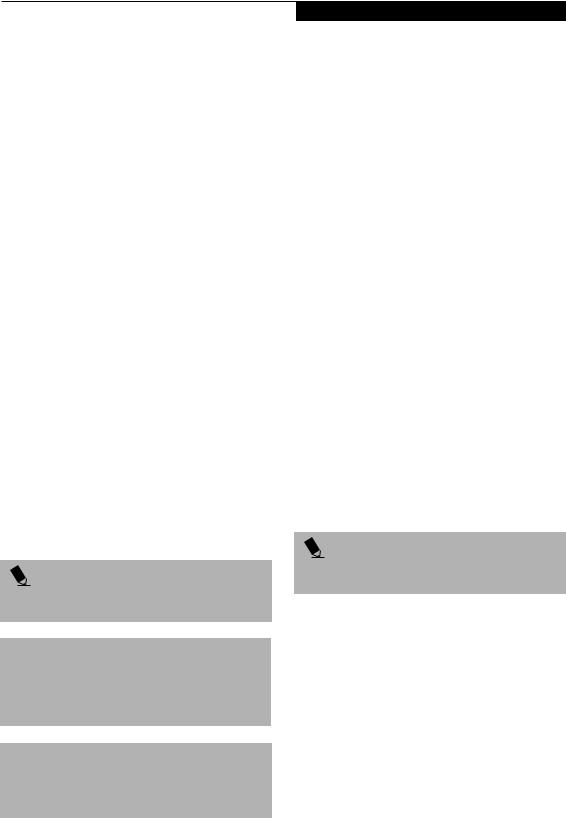
Preface
ABOUT THIS GUIDE
The LifeBook™ C Series from Fujitsu PC Corporation is a powerful notebook computer. It is powered by an Intel® Pentium® III microprocessor, has a built-in color display, a number of possible configurations, and brings the computing power of desktop personal computers (PCs) to a portable environment.
This manual explains how to operate your Fujitsu LifeBook’s hardware and built-in system software. Your LifeBook is compatible with the IBM® PC AT.
Your LifeBook comes with Microsoft® Windows® 98 Second Edition pre-installed.
The Fujitsu LifeBook is a completely self-contained unit with an active-matrix (TFT) color LCD display. It has a powerful interface that enables it to support a variety of optional features.
Conventions Used in the Guide
Keyboard keys appear in brackets.
Example: [FN], [F1], [ESC], [ENTER] and [CTRL].
Pages with additional information about a specific topic are cross-referenced within the text.
Example: (See page xx.)
On screen buttons or menu items appear in bold Example: Click OK to restart your LifeBook.
DOS commands you enter appear in Courier type. Example: Shut down the computer?
P O I N T
The point icon highlights information that will enhance your understanding of the subject material.
 C A U T I O N
C A U T I O N
The caution icon highlights information that is important to your safety, to the safe operation of your computer, or to the integrity of your files. Please read all caution information carefully.
 W A R N I N G
W A R N I N G
The warning icon highlights information that can be hazardous to either you, your LifeBook, or your files. Please read all warning information carefully.
P r e f a c e
FUJITSU PC CONTACT INFORMATION
Service and Support
You can contact Fujitsu Service and Support in the following ways:
■Toll free: 1-800-8FUJITSU (1-800-838-5487)
■Fax: 1-901-259-5700
■E-mail: 8fujitsu@fpc.fujitsu.com
■Web site: http://www.8fujitsu.com
Before you place the call, you should have the following information ready so that the customer support representative can provide you with the fastest possible solution:
■Product name
■Product configuration number
■Product serial number
■Purchase date
■Conditions under which the problem occurred
■Any error messages that have occurred
■Hardware configuration
■Type of device connected, if any
Fujitsu On-line
You can go directly to the on-line Fujitsu Product catalog for your LifeBook by clicking on the LifeBook Accessories Web site URL link, located in the Windows Start menu.
You can also reach Fujitsu Service and Support on-line by clicking on the Fujitsu Service and Support Web site URL link, located in the Service and Support Software folder of the Windows Start menu.
P O I N T
You must have an active internet connection to use the on-line URL links.
WARRANTY
Your LifeBook is backed by a one year International Limited Warranty and includes toll-free technical support. Check the service kit that came with your LifeBook for warranty terms and conditions.
3

L i f e B o o k C S e r i e s – S e c t i o n O n e
4
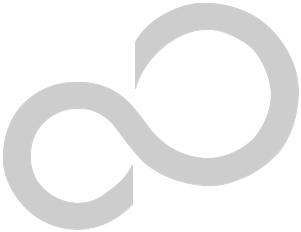
2
Getting to Know Your LifeBook
5

L i f e B o o k C S e r i e s – S e c t i o n T w o
6
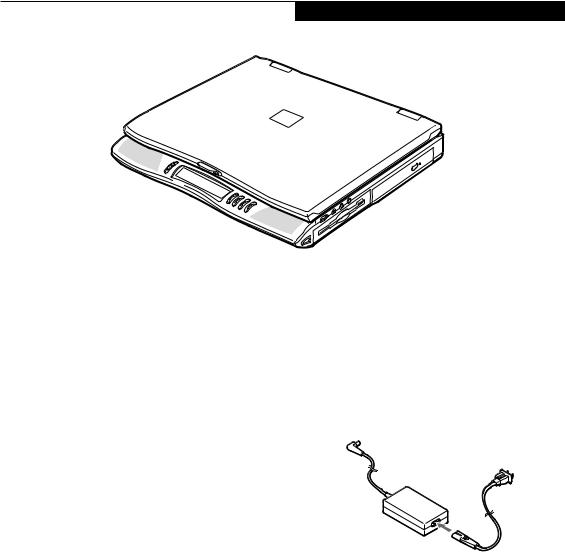
O v e r v i e w
Figure 2-1 Fujitsu C Series LifeBook
Overview
This section describes the components of your Fujitsu LifeBook. We strongly recommend that you read it before using your LifeBook – even if you are already familiar with notebook computers.
UNPACKING
When you receive your LifeBook, unpack it carefully, and compare the parts you have received with the items listed below.
For a Pre-configured model you should have:
■LifeBook C Series from Fujitsu (Figure 2-1)
■Lithium ion battery, pre-installed
■AC adapter with AC power cord (Figure 2-2)
■Phone/Modem (RJ-11) telephone cable
■Recovery CD
■Driver and Application Restore CD
■Getting Started Guide
■User’s Guide
■Product Registration card
■International Limited Warranty Brochure
■Getting Started with Microsoft Windows 98 Second Edition Manual
■First Cabin Registration card and envelope
Once you have checked and confirmed that your LifeBook system is complete, read through the following pages to learn about all of your LifeBook’s components.
Figure 2-2 AC Adapter
7
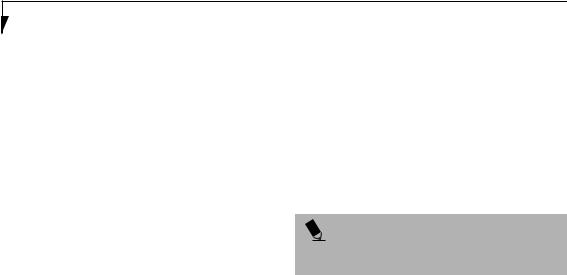
L i f e B o o k C S e r i e s – S e c t i o n T w o
LIFEBOOK FEATURES
The LifeBook C Series is a compact, yet powerful notebook computer available with a variety of features, including: (See Specifications on page 79 for more information)
■Latest high-speed Intel Pentium III mobile processors with SpeedStep technology
■100 MHz SDRAM system memory
■Clear, bright XGA TFT display
■Lithium ion battery
■Built-in 20GB, 15GB or 12GB hard drive
■ATI Mobility-P video, 8MB of video RAM
■External monitor support with simultaneous display capabilities
■Dual monitor support
■LifeBook Application Panel/Audio CD Player
■Internal 56K fax/data/voice modem with V.90 support
■8x DVD drive
■Full audio and video features:
■64 voice wavetable
■Zoomed Video support for full motion video acceleration
■Built-in Pioneer bass reflex stereo speakers
■Stereo line-in jack
■Stereo headphone jack
■Microphone jack
■Digital audio out
■Combination PC card slot accommodates two Type II or one Type III cards
■Fast IrDA (4Mbps) compatible infrared port for wireless data transfer
■Integrated pointing device for superb cursor control and comfort
■Full-size 87-key keyboard with three dedicated Windows keys
■Hot-swappable PS/2 port for external components
■USB device support
■Wireless infrared mouse support
LIFEBOOK SOFTWARE
■Microsoft Windows 98 Second Edition operating system
■Microsoft Internet Explorer
■Microsoft Press Interactive Training for Windows 98
■Microsoft Works 2000
■Quicken 2000
■LapLink 2000
■PC-Doctor for Windows
■PMSet 98
■McAfee.com ActiveShield
■McAfee.com Clinic on-line coupon
■Adobe Acrobat Reader
■Netscape Communicator
■Internet Service Providers:
■AOL
■CompuServe™
■Earthlink
■DVD Player software
P O I N T
Some software may come separately on a CD and will have to be installed.
POPULAR ACCESSORIES
For ordering or additional information on Fujitsu accessories please visit our Web site at www.fujitsupc.com or call 1-877-FPCDirect.
Memory Upgrades
■32MB SDRAM
■64MB SDRAM
■128MB SDRAM
Expansions
■ Universal LAN Hub
Power
■Lithium ion battery
■Auto/Airline Adapter
■AC Adapter
Additional Accessories
■Wireless Infrared Mouse
■Wireless Keyboard and Mouse
■Numeric Keypad
■USB Digital Camera (external)
■Presentation Audio System
■MindPath PocketPoint
■TeleAdapt 16’ TeleCord
■Notebook Guardian Lock
■IBM Modem Saver
Carrying Cases
■Diplomat
■Diplomat with Airpro
■ProPack Backpack
8
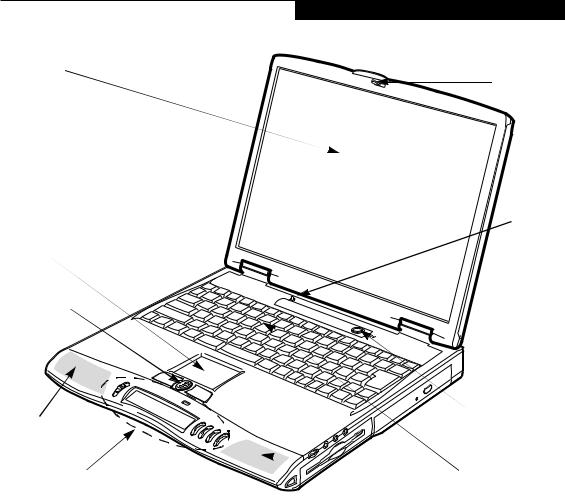
L o c a t i n g t h e C o n t r o l s a n d C o n n e c t o r s
Display Panel
TouchPad
Scroll Button
Stereo Speakers
LifeBook Application Panel  Stereo Speakers
Stereo Speakers
(including CoolView Display)
Figure 2-3 LifeBook with display open
Display
Panel
Latch
Closed
Cover
Switch

 Wireless IR
Wireless IR
Mouse Receiver
Suspend/Resume Button
Keyboard
Locating the Controls
and Connectors
TOP AND FRONT COMPONENTS
The following is a brief description of your LifeBook’s top and front components.
Display Panel Latch
The display panel latch locks and releases the display panel.
Display Panel
The display panel is a color LCD panel with back lighting for the display of text and graphics. (See Display Panel on page 32 for more information)
LifeBook Application Panel
The LifeBook Application Panel allows you to either launch your favorite applications by the touch of a button or to use as an Audio CD-ROM player when
your unit is on or has been shut down from Windows.
(See LifeBook Application Panel on page 24 for more information)
CoolView Display
The CoolView Display presents symbols that correspond to specific components of your LifeBook. (See CoolView Display on page 16 for more information)
Wireless IR Mouse Receiver
The wireless IR mouse receiver allows the use of an optional wireless IR mouse.
Suspend/Resume Button
The Suspend/Resume button allows you to suspend LifeBook activity without powering off, resume your LifeBook from suspend mode, and power on your LifeBook when it has been shut down from Windows 98 Second Edition. (See Suspend/Resume Button on page 36 for more information)
9

L i f e B o o k C S e r i e s – S e c t i o n T w o
Stereo Speakers
The built-in dual speakers allow for stereo sound.
Closed Cover Switch
The closed cover switch turns off the LCD back lighting when the display panel is closed.
Keyboard
A full-size keyboard with dedicated Windows
keys. (See Keyboard on page 19 for more information)
Touchpad Pointing Device
The Touchpad pointing device is a mouse-like cursor control with three buttons (left and right buttons, and scroll button). (See Touchpad Pointing Device on page 19 for more information)
10

L o c a t i n g t h e C o n t r o l s a n d C o n n e c t o r s
Power Switch |
PC Card Slot |
PC Card Eject Buttons |
Lithium ion Battery Bay |
Figure 2-4 LifeBook left-side panel
LEFT-SIDE PANEL COMPONENTS
The following is a brief description of your LifeBook’s left-side components.
Power Switch
This switch is the main power switch for your LifeBook.
PC Card Slots
The PC Card Slots allow you to install two Type II PC Cards or one Type III PC Card. (See PC Cards on page 47 for more information)
Lithium ion Battery Bay
The battery bay contains the internal Lithium ion battery. It can be opened for the removal of the battery when stored over a long period of time or for swapping a discharged battery with a charged Lithium ion battery.(See Lithium ion Battery on page 41 for more information)
11
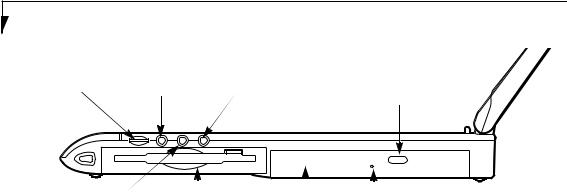
L i f e B o o k C S e r i e s – S e c t i o n T w o
Volume Control |
Headphone Jack |
Microphone Jack |
DVD Eject Button
Stereo Line-in Jack |
|
|
|
|
|
|
|
|
|
|
|
|
|
and Digital Audio-Out |
Floppy Disk Drive |
DVD Drive |
Emergency |
|||
SPDIF |
|
|
|
|
DVD Tray Release |
|
|
|
Figure 2-5 |
LifeBook right-side panel |
|||
RIGHT-SIDE PANEL COMPONENTS
The following is a brief description of your LifeBook’s right-side components.
Headphone Jack
The headphone jack allows you to connect headphones or powered external speakers. (See Headphone Jack on page 53 for more information)
Stereo Line-in Jack
The stereo line-in jack allows you to connect an external audio source. (See Stereo Line-In Jack on page 52 for more information)
Digital Audio-Out
The digital audio-out jack allows you to download digital audio onto Sony™ & Philips Mini-disc player’s SPDIF (Sony Philips Digital Interface) format. (See Digital Audio-Out Connector on page 52 for more information)
Microphone Jack
The microphone jack allows you to connect an external mono microphone. (See Microphone Jack on page 52 for more information)
Volume Control
The volume control provides manual control of the sound level of all audio output. (See Volume Control on page 23 for more information)
DVD Drive
The DVD drive allows you to play DVDs and CD-ROMs on your LifeBook. (See DVD Drive on page 44 for more information)
DVD Eject Button
The DVD Eject button is used to open the DVD tray.
(See DVD Drive on page 44 for more information)
Emergency DVD Tray Release
The Emergency CD Tray Release provides a way to open the CD tray when power is not available to the system.
(See Emergency DVD Tray Release on page 71 for more information)
Floppy Disk Drive
The floppy disk drive provides removable data storage.
(See Floppy Disk Drive on page 43 for more information)
12
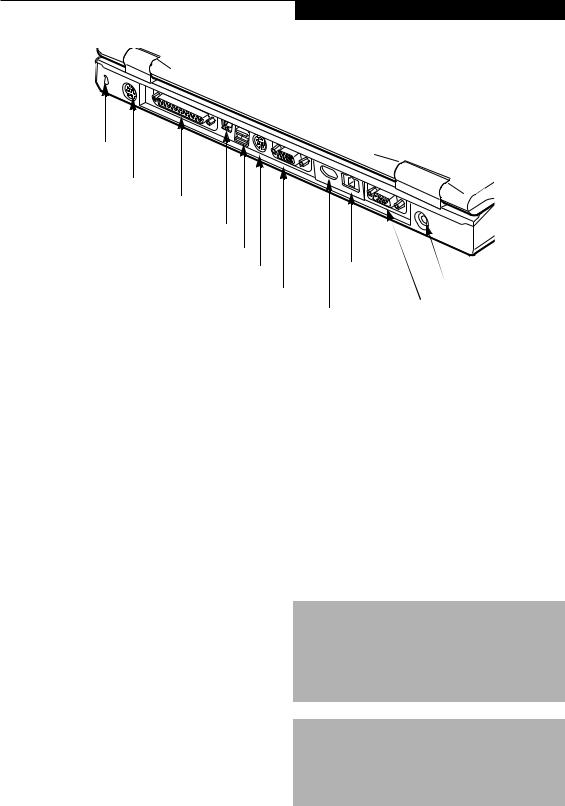
L o c a t i n g t h e C o n t r o l s a n d C o n n e c t o r s
Anti-theft
Lock Slot
PS/2 Port
Parallel Port
1394 Port |
|
|
USB Port |
|
|
S-Video Port |
RJ-11 |
|
Modem Jack |
||
|
||
External Display Port |
DC Power Jack |
|
Serial Port |
||
Infrared Port |
||
|
Figure 2-6 LifeBook back panel
BACK PANEL COMPONENTS
The following is a brief description of your LifeBook’s back panel components.
Anti-theft Lock Slot
The anti-theft lock slot allows you to attach an optional physical lock down device.
PS/2 Port
The PS/2 port allows you to connect an external PS/2 keyboard, mouse or numeric keypad. (See PS/2 Port on page 51 for more information)
Serial Port
The serial port allows you to connect serial (RS-232C) devices. (This is also sometimes referred to as a COMM port.) (See Serial Port on page 51 for more information)
Parallel Port
The parallel port allows you to connect parallel devices. (This is also sometimes referred to as an LPT port.)
(See Parallel Port on page 51 for more information)
1394 Port
The 1394 port is used to connect between your LifeBook and a peripheral such as a digital video camera.(See 1394 Port on page 51 for more information)
S-Video Port
The S-Video output is used to transmit the S-Video signal. (See S-Video Out Port on page 53 for more information)
External Display Port
The external monitor port allows you to connect an external monitor. (See External Monitor Port on page 53 for more information)
Infrared Port
The fast IrDA compatible port allows you to communicate with another IrDA compatible infrared device without a cable. (See Infrared Port on page 52 for more information)
Modem (RJ-11) Telephone Jack
The Modem (RJ-11) telephone jack is for attaching a telephone line to the internal 56K modem. (See Modem (RJ-11) Telephone Jack on page 51 for more information)
 C A U T I O N
C A U T I O N
The internal modem is designed to the ITU-T V.90 standard. Its maximum speed of 53000bps is the highest allowed by FCC, and its actual connection rate depends on the line conditions. The maximum speed is 33600bps at upload.
 C A U T I O N
C A U T I O N
The internal modems on all Fujitsu LifeBooks from Fujitsu PC Corporation are certified for use in the United States and Canada. The modem may be certified in other countries.
13

L i f e B o o k C S e r i e s – S e c t i o n T w o
 W A R N I N G
W A R N I N G
The internal modem is not intended for use with Digital PBX systems. Do not connect the internal modem to a Digital PBX as it may cause serious damage to the internal modem or your entire LifeBook. Consult your PBX manufacturer’s documentation for details. Some hotels have Digital PBX systems. Be sure to find out BEFORE you connect your modem.
USB Port
The USB port allows you to connect Universal Serial Bus devices. (See Universal Serial Bus Port on page 51 for more information)
DC Power Jack
The DC power jack allows you to plug in the AC adapter or the optional Auto/Airline adapter to power your LifeBook and charge the internal Lithium ion battery.
14
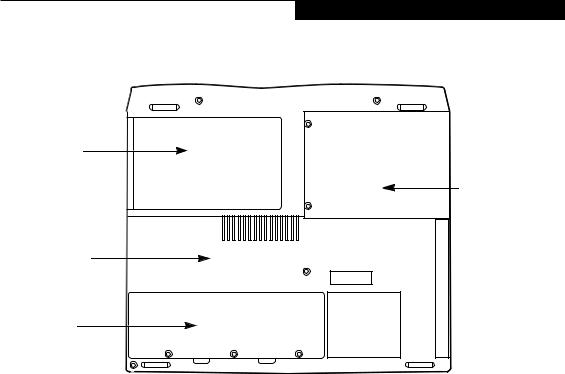
L o c a t i n g t h e C o n t r o l s a n d C o n n e c t o r s
Lithium ion
Battery Bay
Certificate of Authenticity Label (approximate location)
Main Unit and
Configuration
Label
Expansion
RAM Slot
Figure 2-7 LifeBook bottom panel
BOTTOM COMPONENTS
The following is a brief description of your LifeBook’s bottom panel components.
Main Unit and Configuration Label
The configuration label shows the model number and other information about your LifeBook. In addition, the configuration portion of the label has the serial number and manufacturer information that you will need to give your support representative. It identifies the exact version of various components of your LifeBook. (See Configuration Label on page 79 for more information)
Lithium ion Battery Bay
The battery bay contains the internal Lithium ion battery. It can be opened for the removal of the battery when stored over a long period of time or for swapping a discharged battery with a charged Lithium ion battery.
(See Lithium ion Battery on page 41 for more information)
Expansion RAM Slot
The expansion RAM slot allows you to add optional memory upgrades. (See Installing a Memory Upgrade Module on page 49 for more information)
15
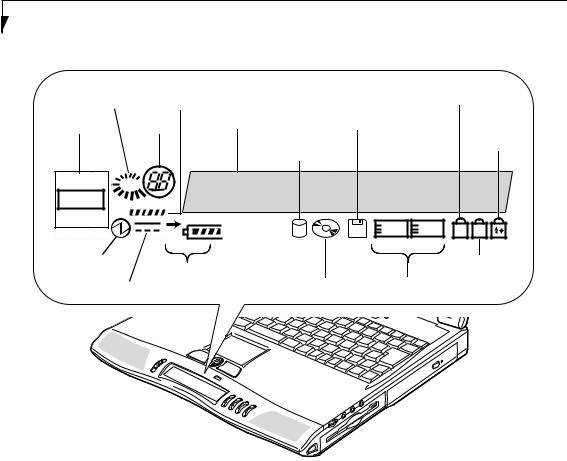
L i f e B o o k C S e r i e s – S e c t i o n T w o
|
|
Volume |
|
Floppy |
NumLock |
|
CD Mark |
Level |
|
||||
|
|
Disk Drive |
|
|||
|
|
|
Message Display |
|
||
Mode |
CD Track |
Access |
Scroll |
|||
|
||||||
Hard Disk |
|
|||||
|
|
|
|
Lock |
||
|
|
|
Drive Access |
|
|
|
Application |
TRACK |
|
|
|
|
|
|
|
|
|
|
|
|
|
|
Lock |
|
|
|
|
|
|
|
CD Player |
VOL |
|
|
|
|
|
|
|
|
|
1 |
2 |
|
|
|
|
|
1 |
|
1 |
A |
||
Suspend/ |
|
|
|
|
1 |
A |
|
|
|
|
|
|
|
|
|
Resume |
|
|
|
|
|
|
Caps |
State |
|
Battery Installed |
|
|
|
|
|
|
|
|
|
|
Lock |
||
|
|
Battery Charge |
|
PC Card |
|
|
|
AC Adapter |
DVD Access |
|
|
|
|||
Battery Level |
Access |
|
|
|
|||
|
|
|
|
||||
Figure 2-8 CoolView Display
CoolView Display
The CoolView Display is located at the front of your LifeBook, just below the touch pad. Within this display are symbols that correspond to specific components of your Fujitsu LifeBook. These symbols tell you how each of those components are operating. (Figure 2-8)
MODE INDICATOR
The Mode indicator displays the current mode, as determined by the position of the selector switch.
 CD MARK
CD MARK
The CD Mark indicator revolves when an audio CD is being played back, when the LifeBook is in standby mode.
CD TRACK
The CD Track indicator displays the number of the track being played.
■Numerals indicate the track currently being played; when the player is in the stopped state, the number displayed is the first track on the disk.
■Dashes appear when no audio CD is set or when the CD is being read.
VOLUME LEVEL INDICATOR
The Volume indicator displays the current volume of the DVD Player.
 SUSPEND/RESUME INDICATOR
SUSPEND/RESUME INDICATOR
The Suspend/Resume indicator symbol states whether your system is operational. It has several different states, each of which tells you what mode your LifeBook is
in at that time.
■On: This means that there is power to your LifeBook and that it is ready for use.
■Flashing: This means that your LifeBook is in Suspend mode.
■Off: This means that your system is either in Hibernation (Save-to-Disk) mode, or that your LifeBook has been turned off with the power switch.
16
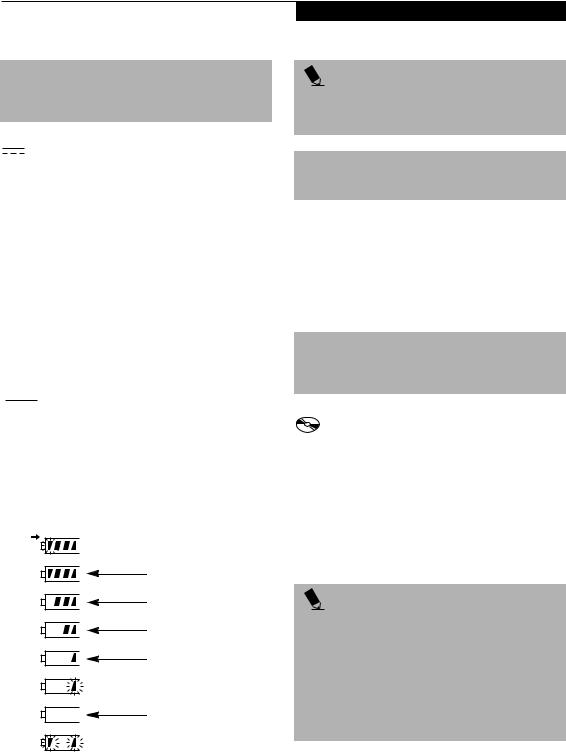
 C A U T I O N
C A U T I O N
Your LifeBook’s power switch must be turned off to prevent all current draw.
AC ADAPTER INDICATOR
The AC Adapter indicator states whether your LifeBook is operating from the AC adapter, the Auto/Airline adapter or the batteries. This icon has two different states that can tell you what power source your LifeBook is using.
■On: This means that either of the adapters are currently in use.
■Off: Power is only coming from the batteries, and you do not have an adapter connected.
If you are charging your battery, the Power indicator symbol will remain on, even if your LifeBook is shut off. The Power indicator symbol will also remain on if you have an adapter connected and are shut down from Windows, but have not turned off the power switch.


 BATTERY LEVEL INDICATORS
BATTERY LEVEL INDICATORS
The Battery Level indicators state whether or not the primary Lithium ion battery is installed. In addition, this symbol states how much charge is available within the battery. The symbol will only be displayed for a battery that is currently installed in your LifeBook.
(Figure 2-9)
 76%–100% Charging
76%–100% Charging
76%–100%
51%–75%
26%–50%
11%–25%
 Low Warning <11%
Low Warning <11%
Critical Low or
Dead Battery
 Shorted Battery
Shorted Battery
Figure 2-9 Battery Charge Status
C o o l V i e w D i s p l a y
P O I N T
If there is no battery activity, the adapters are not connected, and the power switch is Off; the Battery Level indicators will also be off.
 C A U T I O N
C A U T I O N
A shorted battery is damaged and must be replaced.
 BATTERY CHARGING INDICATORS
BATTERY CHARGING INDICATORS
Located to the left of the Battery Level indicators is a small arrow symbol. This symbol states whether the battery is charging. This indicator operates whether the power switch is in the On or Off position, and will flash if the battery is too hot or cold to charge. (Figure 2-9)
 C A U T I O N
C A U T I O N
Batteries subjected to shocks, vibration or extreme temperatures can be permanently damaged.
DVD DRIVE ACCESS INDICATOR
The DVD Drive Access indicator tells you that the DVD drive is being accessed. If the Auto Insert Notification function is active, the indicator will flash periodically when your system is checking the DVD drive. If the Auto Insert Notification function is not active, the indicator will only flash when you access the DVD drive. The default setting is the Auto Insert Notification function active. (See Auto Insert Notification Function on page 46 for more information)
P O I N T
The Windows 98 Second Edition DVD Auto Insert Notification function will periodically check for a DVD installed in the drive, causing the DVD Access indicator to flash. The DVD automatic insertion function allows your system to automatically start a DVD as soon as it is inserted in the drive and the tray is closed. It will begin playing an audio DVD/CD or will start an application if the DVD/CD has an auto-run file.(See Auto Insert Notification Function on page 46 for more information)
17
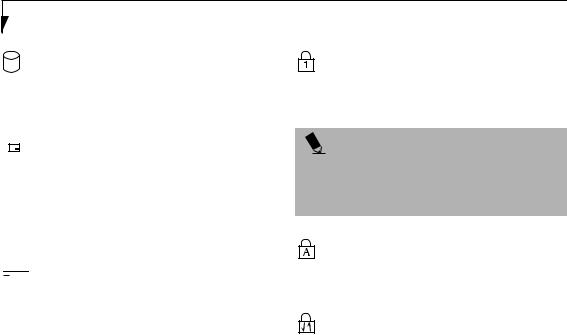
L i f e B o o k C S e r i e s – S e c t i o n T w o
HARD DRIVE ACCESS INDICATOR
The Hard Drive Access indicator states whether your internal hard drive or optional second hard drive is being accessed.
 FLOPPY DISK DRIVE ACCESS INDICATOR
FLOPPY DISK DRIVE ACCESS INDICATOR
The Floppy Disk Drive Access indicator states whether the floppy disk drive is being accessed. This indicator will flash if your software tries to access a disk even if no floppy disk drive is installed. (See Floppy Disk Drive on page 43 for more information)

 PC CARD ACCESS INDICATORS
PC CARD ACCESS INDICATORS
The PC Card Access indicator(s) state whether or not your LifeBook is accessing a PC Card(s). The indicator will flash if your software tries to access a PC Card even if there is no card installed. The number inside the indicator refers to which PC Card slot is being accessed. (See PC Cards on page 47 for more information)
NUMLK INDICATOR
The NumLk indicator states that the internal keyboard is set in ten-key numeric keypad mode.
P O I N T
If you are using the optional external numerical keypad, pressing the [NumLk] key will activate the external keypad. The indicator will come on, however it will not change any of the functionality of your keyboard keys.
CAPSLOCK INDICATOR
The CapsLock indicator states that your keyboard is set to type in all capital letters.
SCRLK INDICATOR
The ScrLk indicator states that your scroll lock is active.
18
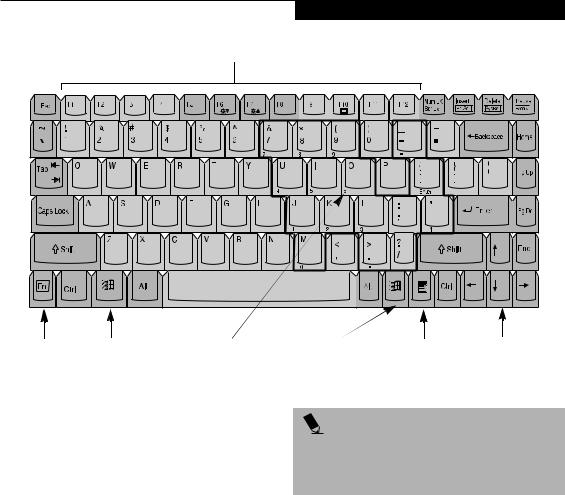
K e y b o a r d
Function Keys
Fn Key |
Start Key |
Numeric Keypad |
Start Key |
Application Key |
Cursor Keys |
Figure 2-10 Keyboard
Keyboard
USING THE KEYBOARD
Your Fujitsu LifeBook has an integral 87-key keyboard. The keys perform all the standard functions of a 101-key keyboard, including the Windows keys and other special function keys. This section describes the following keys.
■Numeric keypad
■Cursor keys
■Function keys
■Windows keys
NUMERIC KEYPAD
Certain keys on the keyboard perform dual functions as both standard character keys and numeric keypad keys. NumLk can be activated by pressing the [NumLk] keys. Turning off the NumLk feature is done the same way.
Once this feature is activated you can enter numerals 0 through 9, perform addition ( + ), subtraction ( - ), multiplication ( * ), or division ( / ), and enter decimal points ( . ) using the keys designated as ten-key function keys. The keys in the numeric keypad are marked on the front edge of the key to indicate their secondary functions.
P O I N T
If you are using the optional external numerical keypad, pressing the [NumLk] key will activate the external keypad. The indicator will come on, however it will not change any of the functionality of your keyboard keys.
WINDOWS KEYS
Your LifeBook has three Windows keys, consisting of two Start keys and an Application key. The two Start keys display the Start menu. This button functions the same as your on-screen Start menu button. The Application key functions the same as your right mouse button and displays shortcut menus for the selected item. (Please refer to your Windows documentation for additional information regarding the Windows keys.)
CURSOR KEYS
The cursor keys are the four arrow keys on the keyboard which allow you to move the cursor up, down, left and right in applications. In programs such as Windows Explorer, it moves the “focus” (selects the next item up, down, left, or right).
19

L i f e B o o k C S e r i e s – S e c t i o n T w o
FUNCTION KEYS
Your LifeBook has 12 function keys, F1 through F12. The functions assigned to these keys differ for each application. You should refer to your software documentation to find out how these keys are used.
The [FN] key provides extended functions for the LifeBook and is always used in conjunction with another key.
■[FN+F5]: Pressing [F5] while holding [FN] allows you to toggle between video compensation and no compensation. (Video compensation controls spacing on the display. When it is enabled, displays with less
than 1024 x 768 or 800 x 600 pixel resolution will still cover the entire screen.)
■[FN+F6]: Pressing [F6] repeatedly while holding [FN] will lower the brightness of your display.
■[FN+F7]: Pressing [F7] repeatedly while holding [FN] will increase the brightness of the display.
■[FN+F10]: Pressing [F10] while holding [FN] allows you to change your selection of where to send your display video. Each time you press the combination of keys you will step to the next choice. The choices, in order, are: built-in display panel only, both built-in display panel and external monitor or external monitor only.
20
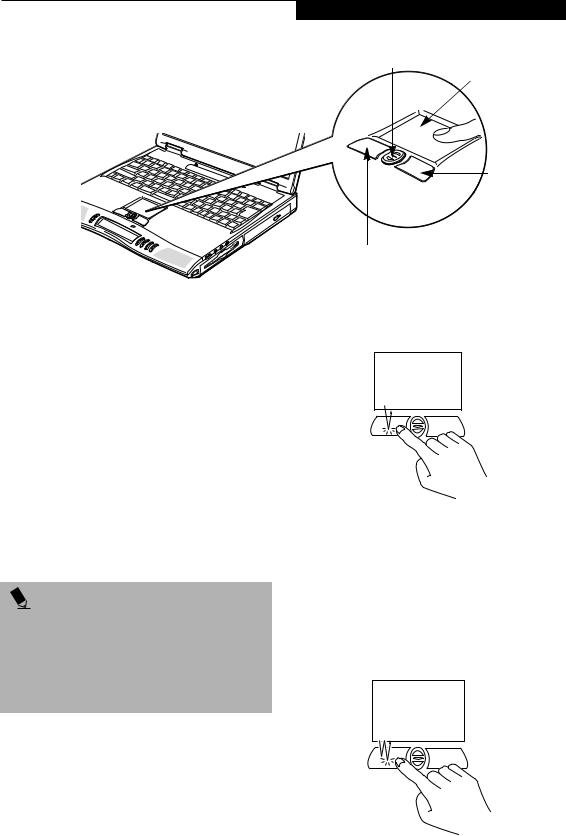
T o u c h p a d P o i n t i n g D e v i c e
Scrolling Button
Touchpad
Right Button
Left Button
Figure 2-11 Touchpad pointing device
Touchpad Pointing Device
The Touchpad pointing device comes built into your Fujitsu LifeBook. It is used to control the movement of the pointer to select items on your display panel. The Touchpad is composed of a cursor control, a left and right button, and a scrolling button. The cursor control works the same way a mouse does, and moves the cursor around the display. It only requires light pressure with the tip of your finger. The left and right buttons function the same as mouse buttons. The actual functionality of the buttons may vary depending on the application that is being used. The scrolling button allows you to navigate quickly through pages, without having to use the scroll bars. (Figure 2-11)
P O I N T
An external mouse can be connected to either the USB or PS/2 port on your LifeBook or port replicator, and used simultaneously with the Touchpad. However, if you boot the system with an external mouse connected the Touchpad will be disabled or enabled depending on the specifications in your BIOS settings. (See BIOS Setup Utility on page 33 for more information)
CLICKING
Clicking means pushing and releasing a button. To left-click, move the cursor to the item you wish
to select, press the left button once, and then immediately release it. To right-click, move the mouse cursor to the item you wish to select, press the right button once, and then immediately release it. You also have the option to perform the clicking operation by tapping lightly on the Touchpad once. (Figure 2-12)
Figure 2-12 Clicking
DOUBLE-CLICKING
Double-clicking means pushing and releasing the left button twice in rapid succession. This procedure does not function with the right button. To double-click, move the cursor to the item you wish to select, press the left button twice, and then immediately release it. You also have the option to perform the double-click operation by tapping lightly on the Touchpad twice.
(Figure 2-13)
Figure 2-13 Double-clicking
21
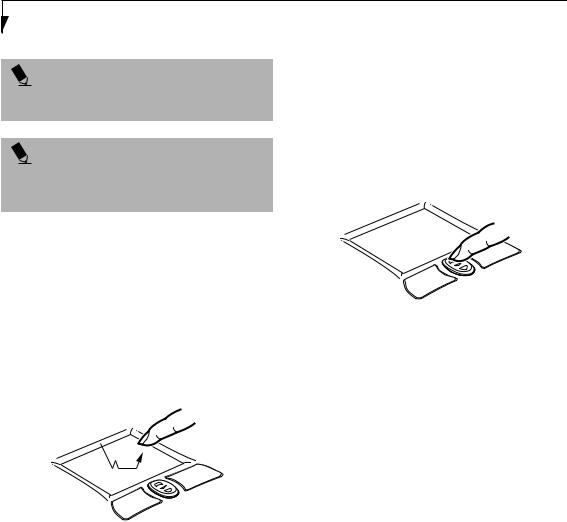
L i f e B o o k C S e r i e s – S e c t i o n T w o
P O I N T
If the interval between clicks is too long, the double-click will not be executed.
P O I N T
Parameters for the Touchpad can be adjusted from the Mouse Properties dialog box located in the Windows Control Panel.
DRAGGING
Dragging means pressing and holding the left button, while moving the cursor. To drag, move the cursor to the item you wish to move. Press and hold the left button while moving the item to its new location
and then release it. Dragging can also be done using the Touchpad. First, tap the Touchpad twice over the item you wish to move making sure to leave your finger on the pad after the final tap. Next, move the object to its new location by moving your finger across the Touchpad, and then release your finger. (Figure 2-14)
Figure 2-14 Dragging
SCROLLING
Using the Scrolling button allows you to navigate through a document quickly without using the window’s scroll bars. This is particularly useful when you are navigating through on-line pages. To use the Scrolling button, press the crescent shape at the top or bottom of the button to scroll up or down a page. When you have reached the desired section of the page, release the button. (Figure 2-15)
Figure 2-15 Scrolling
TOUCHPAD CONTROL ADJUSTMENT
The Windows Control Panel allows you to customize your Touchpad with selections made from within the Mouse Properties dialog box.
22
